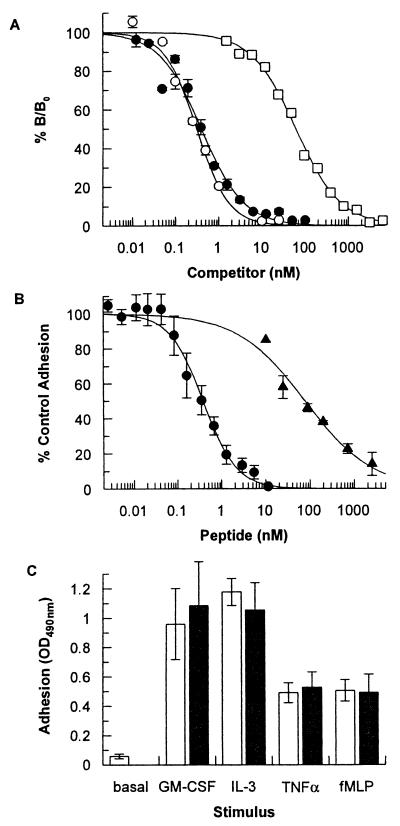Figure 3.
Pharmacological characterization of antagonist peptides. (A) Competition-binding assay using TF-1 cells. The binding of 125I-labeled human IL-5 to TF-1 erythroleukemia cells was reduced by competition with various concentrations of human IL-5 (○), AF17121 (□), or AF18748 (●). Results are expressed as percentage of maximum specific binding (% B/B0). Mean total binding was 1,074 ± 188 cpm and nonspecific binding was 115 ± 20 cpm. Data are mean ± SEM for three separate experiments for IL-5 and AF18748, and mean of two separate experiments for AF17121. (B) IL-5-induced eosinophil activation assay. The adherence of purified human eosinophils to IgG-coated plates in response to stimulation with 20 pM IL-5 was assessed in the presence of various concentrations of AF17121 (▴) or AF18748 (●). Data are mean ± SEM for four separate experiments for AF17121 and for six separate experiments for AF18748. The average OD490 reading for IL-5-stimulated cells was 0.90 ± 0.09 compared to unstimulated levels of 0.17 ± 0.03. (C) AF18748 specificity assay. Purified eosinophils were assayed for their ability to adhere to IgG-coated plates after stimulation with 6 pM human GM-CSF, 180 pM human IL-3, 1 nM human tumor necrosis factor-α , or 100 nM fMet-Leu-Phe in the presence (closed bars) or absence (open bars) of 1 μM AF18748. The concentration of each cytokine used is one that elicits 80% of the maximal response achievable with that cytokine. Data are mean ± SEM for three separate experiments.

